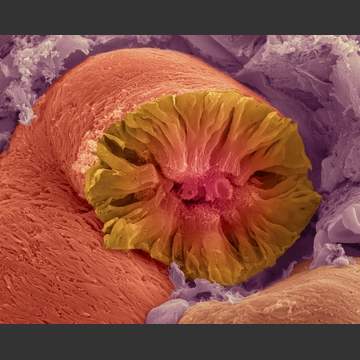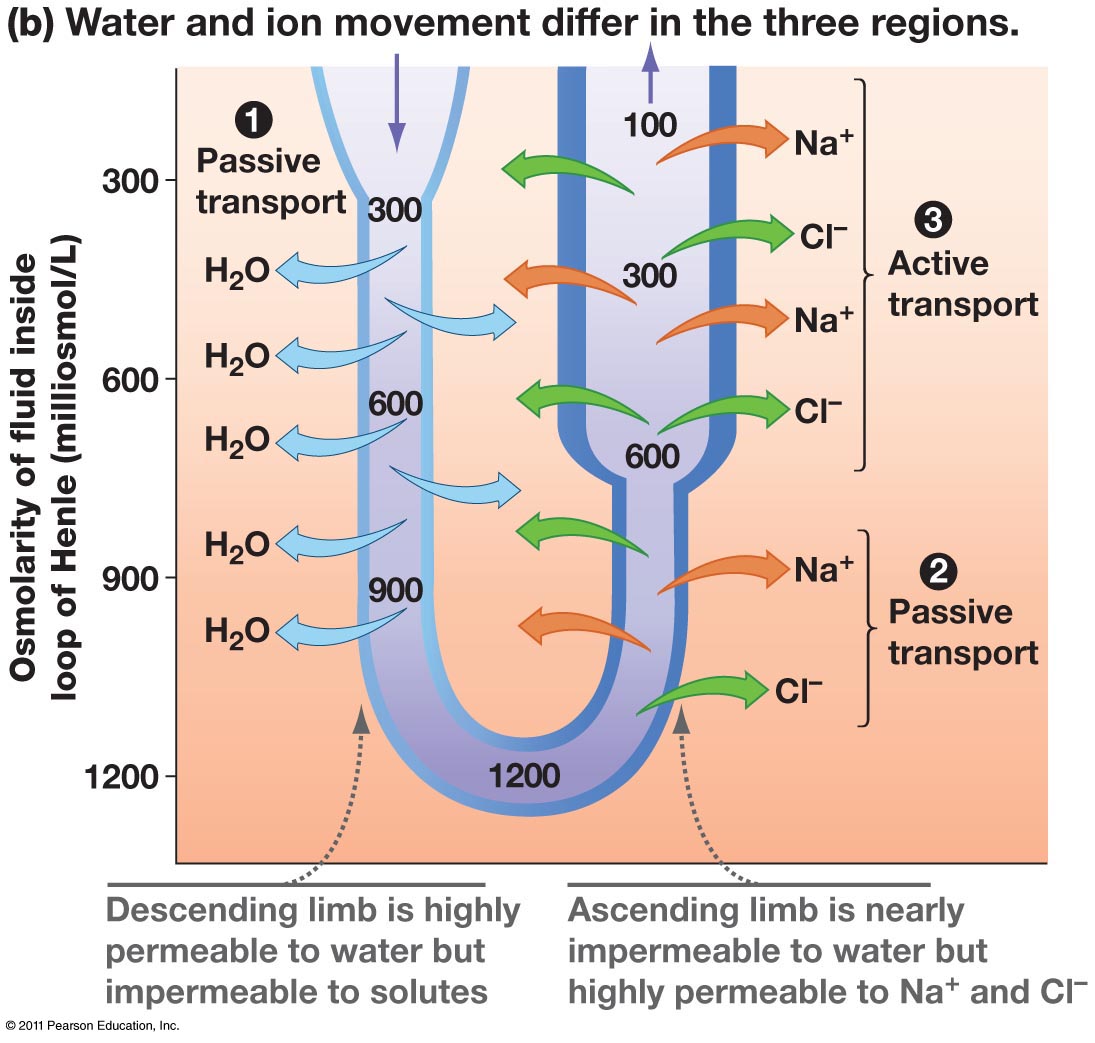General Biology, lecture on Kidney and Elimination
IX. Excretion - elimination
A. What must be eliminated?
1. End products of metabolism
a. nitrogenous wastes from protein catabolism ð deamination
of amino acids
i. Ammonia NH3 or ammonium ions NH4+
- very toxic, very soluble
ii. Urea CO(NH2)2 = 2 ammonia
- toxic, soluble
iii. Uric Acid C5H4N4O3 = 3 ammonia
- not very toxic or soluble
b. CO2 from oxidative metabolism, eg. Kreb's cycle
2. Water and Salts
a. to maintain osmotic balance
3. Toxic substances ingested
B. Excretion in Aquatic versus Terrestrial organisms
1. Aquatic: Salt water versus freshwater adaptations
a. saltwater is hyperosmotic to bodily fluids
\ H2O must be conserved and salt excreted
i. many organisms (e.g. teleost/bony fishes) take on NaCl
through the gills and gut, some H2O follows,
then excrete Cl- (and Na+) via chloride cells in the gills
(1) H2O is lost through the gills (osmosis)
(2) more salt must be pumped out by Cl- cells
ii. some organisms (e.g. sharks) ò salt diffusion into their
bodies by keeping the Ý blood osmotic potential
(1) by keeping plasma [urea] high
b. freshwater inhabitants live in a medium hyposmotic
to their bodily fluids
i. salt must be actively taken up, and water excreted
ii. dilute urine made by kidneys
2. Ammonia easily diffuses into aquatic media
3. Terrestrial organisms must ingest and conserve H2O, but also take in salts
a. water and salts must always be in balance
i. eg. for neural, muscular function
C. Excretion from Single-vs-Multiple Cell Organisms
1. Single celled organisms use simple means for eliminating waste
a. ammonia diffuses rapidly
b. contractile vacuoles - exocytosis
2. Multiple celled organisms must move waste to the periphery
and detoxify it until it reaches the periphery
a. very toxic ammonia is converted to urea or uric acid
b. flatworms - flame cells
c. earthworms - nephridia
d. insects - malpighian tubules
e. vertebrates - kidneys - functional unit: nephron
X. Kidney
A. bean shaped
B. back or dorsal
1. just below the ribs
C. Blood supply
1. Renal (means kidney) Artery
2. 2 capillary beds in succession (portal system)
3. Renal vein
D. Nephron...each kidney unit...millions
1. 1st capillary bed = Glomerulus
2. Bowman's capsule... surrounds glomeruli
3. Proximal (close) convoluted (curved) tubule
4. Loop of Henle
5. Distal (far) convoluted tubule
6. Collecting duct...4 + 6 makes pyramids
E. Kidney to outside
7. Hilus or Renal Sinus
8. Ureter
9. Urinary bladder
10. Urethra
F. Function
1. fluid + wastes + salts + anything small filtered
a. out of the glomerulus into the Bowman's capsule
b. blood under high pressure in the glomerulus: aids in filtration
2. filtrate travels through nephron (more later)
3. At the ascending (upward) loop of Henle
a. NaCl is actively transported out of the nephron
4. because of concentration gradient it passively moves back
into the descending (downward) loop of Henle
a. carried back to the upward loop and actively pumped out again
b. counter-current mechanism
5. Concentration gradient
a. cortex (low concentration) to medulla (high concentration)
b. fish have no Loop of Henle - hence the urine is not concentrated
6. collecting tubule permeable or not permeable to water
a. AVP (or ADH) makes it permeable
b. diuretic = increase urine
c. when AVP is missing ðtubule isn't permeable
7. water flows out along concentration gradient
a. if AVP present È concentrated urine
b. if AVP not present
i. inhibited by diuretic
-alcohol
-caffeine
-blood pressure medicines
ii. urine very dilute (a lot of water is sent to the bladder)
8. blood flows from glomerulus to efferent (away from) arteriole
a. blood to glomerulus from afferent arteriole
b. efferent arteriole = portal vessel
9. from efferent arteriole into vasa recta (capillary bed)
a. surrounds loop of Henle
10. blood becomes more and more concentrated as well
a. along the concentration gradient by countercurrent mechanism
i. vasa recta flows down the ascending Henle
ðñ concentration
ii. vasa recta flows up the descending Henle
+ collecting duct ðñ H2O ðò concentration
b. 99% of all the filtered fluid is reabsorbed
i. by the time the vasa recta vessels reach the renal vein
G. Reabsorption
1. reabsorption occurs into the vasa recta
a. counter current up descending Henle + collecting duct ðñ H2O
2. primary site of reabsorption: from the Proximal convoluted tubule
a. 65% of all reabsorption here into beginning vasa recta
b. H2O (even some urea)...osmosis
glucose, amino acids, cations: Na+, K+, Ca++...active transport
anions: Cl-, HCO3-, PO4-...diffusion
proteins...pinocytosis (endocytosis)
c. also the primary site of secretion...drugs
3. Loop of Henle...15%
4. Regulation of reabsorption (AVP and other hormones)
a. distal convoluted tubule...10%
b. collecting duct...4-8%
c. always get back 75-85% of what is filtered out of the glomerulus...
i. regulation only controls 4-18%

